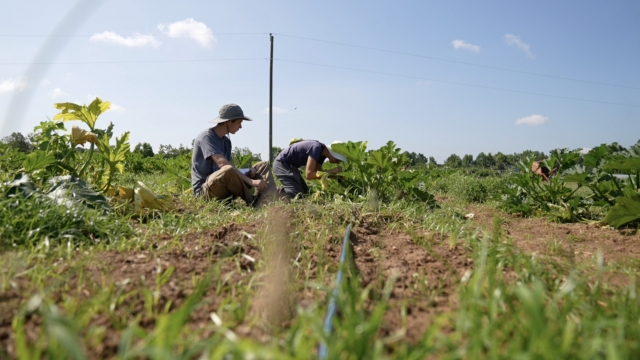At Love is Love Farm, the summer growing season is well underway.
"We grow organic, mixed vegetables, cut flowers and transplants as well," said Russell Honderd, one of the farm's co-owners.
For now, all of their growth takes place on 42 acres in Mansfield, Georgia. However, the organic farm is preparing to expand, after acquiring another 27 acres down the road.
"Organic farming has a lot of different benefits for us," Honderd said. "One is just financial: you get a higher dollar value for the things that you grow."
Yet turning the new 27 acres from a traditional into an organic farm wasn't easy.
"For organic certification, there's a three-year waiting period between the last application of forbidden inputs," Honderd said. "We also had to be really diligent that those weren't there still or they weren't active in the soil."
Love is Love Farm could wait out the three years on that plot of land, though, because they could rely on their current 42 acres of organic farmland.
Most farmers, though, only have one farm. That presents a potential barrier for them if they want to go organic, which is defined by the federal government as using no synthetic fertilizers or pesticides.
SEE MORE: Urban farm launches support program to help nourish a food desert
Numbers from the Organic Trade Association show that, for the first time ever, total sales of organic products in the U.S. topped $67 billion last year. That is more than double the $30 billion seen just ten years ago.
"The market's booming. We've seen an increase in the demand for consumers to have organic produce," said Kate Cassity-Duffey, an assistant professor of organic horticulture at the University of Georgia.
Cassity-Duffey is among the UGA researchers now working with area farmers on a new three-year study, funded in part by the USDA, to see if there is a way to smooth the transition from traditional to organic farming.
"We hope that we can produce productive land quicker," Cassity-Duffey said. "What's the fastest way we can have a farmer start hitting the yields that they need to make money?"
That research includes planting so-called 'cover crops,' which include certain types of grasses and legumes, like alfalfa and spinach, to see how they impact the soil quality, as well as pests and diseases, that are unique to the South.
According to the USDA National Agricultural Statistics Service, compared to states in other regions of the country, southern states have fewer certified organic farms.
SEE MORE: Sustainable farming: How technology can optimize food production
California has 3,061 certified organic farms, while New York (1,407), Wisconsin (1,455) and Pennsylvania (1,125) all have more than 1,000. In Iowa, there are 799 organic farms.
However, southern states have far fewer. Georgia leads the region with only 121, while Tennessee (46), South Carolina (40), Louisiana (19), Alabama (18) and Mississippi (15) lag behind.
"I think probably the biggest thing is really our climate," Cassity-Duffey said. "The South is a great place because we have year-round production potential, but also we have high temperatures, high relative humidity and high rainfall and that kind of means more weeds, more disease and other pest problems."
Researchers believe improving the transition to organic farming in the South could have several effects. It's not clear if price would be one, but they say it would allow consumers to buy organic produce grown much closer to home, which could be a benefit to the local economy.
"When you go to the grocery store, you do see a lot of these food crops coming from other regions, specifically California," Cassity-Duffey said. "It would help with locality and would also help with bringing in some of that money we're spending at the grocery store into our local systems."
Back at Love is Love Farm, they're all in, and are now working with the UGA researchers on their study.
"That partnership between us and UGA helps eliminate some of the risks that we face as farmers," Honderd said. "It's really important to be growing in a way that is supportive and protective of the environment in our community."
Trending stories at Scrippsnews.com





